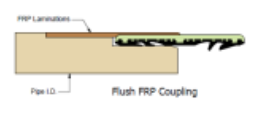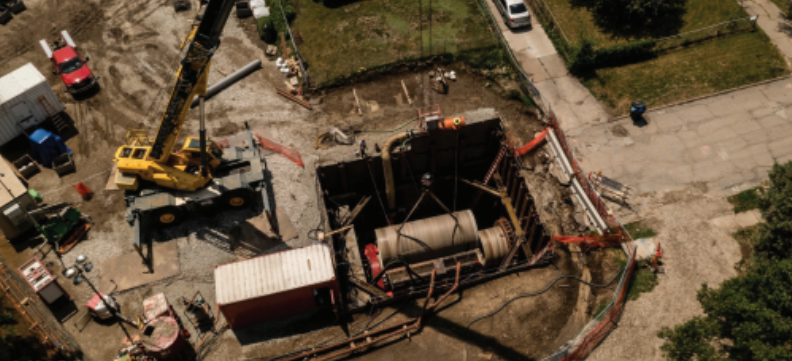Most major cities in North America have a microtunneling project ongoing, recently completed or about to begin.
The trenchless installation process is omnipresent as system owners look to install critical underground infrastructure in already congested corridors. To check the pulse of the industry, we’ve assembled this Special Report: Advancements in Microtunneling.
Hobas Pipe was thrilled to support this special report.
HOBAS Pipe: Fiberglass Pipe For Direct Microtunneling
In North America, the infrastructure industry has relied heavily on reinforced concrete pipe (RCP), vitrified clay pipe (VCP), and briefly, polymer concrete pipes (PCP); these materials often possess limitations that may not be readily apparent to owners and the engineering community.
For more than 70 years, RCP pipes have been used in jack and bore installations in North America. While it is a popular solution for storm drains, RCP pipes are susceptible to microbial-induced hydrogen sulfite (H2S) and resulting sulfuric acid corrosion present in sewers.
The acids in sewer systems deteriorate Portland-cement-based concrete pipes, resulting in a shortened life span of the infrastructure.
The industry used coatings, tar, epoxy, and plastic liners (PVC and HDPE) to extend the RCP pipe lifespan, but these bonding issues remain a persistent challenge. This, coupled with difficulties in joint seal welding and infiltration through existing wall cracks, significantly reduced the performance of RCP pipes, posing a long-term threat to infrastructure integrity.
Although the advantage of RCP is that it is available in large sizes — as large as 144 in. in certain parts of North America — it limits its use to a localized project due to weight.
Since 1982, fiberglass reinforced polymer mortar pipes (FRPM) have been successfully used for direct jacked micro tunneling installations. With almost half a century of production and research, Germany pioneered FRPM pipe solutions, and now, they are available from various manufacturers globally. FRPM pipes can solve several unique problems that traditional jacked pipes pose. Below are the top six benefits of FRPM pipe:
1) Built-in Corrosion Resistance for 150-year Service Life
Fiberglass-reinforced polymer pipes are designed to last and resist compounds and environments that are naturally corrosive to traditional materials while matching them on strength, weight, and ease of handling, extending the service life to ensure sewer and water can be transported reliably for generations.
2) Lighter Weight
Due to their composite construction, fiberglass pipes are between four to six times lighter than comparable RCP and VCP pipes, translating into significant overall savings, including lower required jacking loads and reduction in both shaft and jacking block along with smaller jacking frames to accomplish the task.
3) No Bentonite Absorption
During microtunneling operations, traditional RCP pipes absorb much water in the lubrication mix, and bentonite becomes dry, which increases friction and requires frequent replenishment. In contrast, FRPM pipes are completely non porous and waterproof, resulting in sig nificantly reduced bentonite usage — and reduced environmental impact — and consistently low jacking forces through out the microtunneling operation.
4) Smaller Outside Diameter (O.D.)

FRPM features the smallest O.D. amongst the jacking pipes when comparing RCP, PCCP, and VCP pipes. Take a 60-inch FRPM pipe, for example. Its O.D. is only 63 inches, while the same size CLASS IV pipe in traditional materials would require an OD exceeding 71 in. This significant drop in machine size, the volume of excavation and separation plant volume cost, and faster bore results in cost-saving advantages.
5) Pressure Jacking Pipe
For pressure force main and water feeder mains, the pipe options have been limited to pre-stressed concrete cylinder pipe (PCCP) for the longest time. With advancements in composite pipe technology, the pressure FRPM jacking pipe with NSF-61 potable water rating is now available in up to 250 psi class design.
We should also note that the pipe joints for pressure jacking pipes are different than regular jacked pipes. Our flush-bell spigot is limited to 50 psi pressure. Full pressure-rated couplings are required for higher water transmission or sewer force mains. These are often achieved using a full-face (end-to-end) EPDM sealing gasket embedded within a filament wound-coupling. This not only provides a full pressure rating but also eliminates machining gasket grooves in the pipe spigots and maintains the rating throughout the pipe system.
6) Curved Microtunneling
In recent years, more engineers are looking into curved jacking as a solution to navigate around underground ob stacles and eliminate extra access shafts. Hobas is ready to assist with the design team and contractors involved in such projects. In the past, curves have been considered an anomaly in the microtunneling world. Today, the higher intrinsic risk of curved microtunneling can be offset by the large benefits it may bring. Regardless of the pipe material selected, any pipe will require a special design and installation practices.
While generally stronger than other pipe jacking materials, FRP pipes have a lower compressive modulus than rigid pipes such as concrete. This attribute provides an important benefit for the redistribution of jacking forces under loading conditions. By allowing this re-distribution of load, the pipe is not susceptible to spalling at the pipe ends like many other brittle products. This built-in feature means no additional cushions or joint treatment is needed with FRPM jacking operations.
When an FRP pipe is slightly eccentrically loaded, such as in steering situations (curves), the area of the pipe which has higher load applied, shortens in length more than the opposite pipe wall while still maintaining full contact area. An eccentrically loaded pipe will inherently have a reduced jacking capacity. This needs to be considered when designing the radius of curvature and determining the pipe joint lengths.
The diagram shows the deformation ∆ at an and angle a due to an eccentric push load P.
FRPM has revolutionized the trench less pipe market since its inception over 40 years ago. Offered in diameters ranging from 24 to 126 in. (600 to 3,200 mm) and pressure classes up to 250 psi, it empowers sustainable infrastructure projects with its unmatched environmental benefits and 150-year service life. FRPM offers unparalleled advantages for infrastructure investment.
Gabriel Castelblanco, P.E., is with Hobas Pipe USA, Inc.
Learn more about the benefits of using revolutionary HOBAS Pipe.



